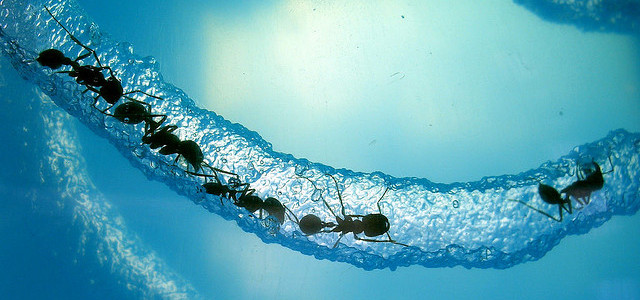
When most of us make our first foray into running proteins on a gel, we use a standard Tris-glycine gel. And why not? Unless you are running a very large protein or a little itty-bitty protein, you probably get pretty good protein resolution.
But your world doesn’t have to be limited to Tris-glycine gels. You can improve your protein resolution by branching out to alternative gel buffer systems.
First, a little background
PAGE gels utilize a discontinuous buffer system. This means that two ions with different electrophoretic mobilities form a moving boundary when electricity is applied. Tris-glycine gels contain a moving front of Cl- ions (from the Tris-HCl in the gel) and negatively charged glycine ions from the tank buffer. The glycine ions travel slower than the chlorine ions through the low pH stacking gel (pH 6.8) causing a narrow zone in which the proteins are concentrated. When the moving front hits the higher pH resolving gel (pH 8.8), the glycine ions move quickly past the chlorine ions pulling the proteins along through the gel. Proteins travel within this wider boundary and move at different rates due to the sieving effect of the acrylamide gel.
It makes sense then, that the separation characteristics of the gel, and thus protein resolution, can be altered by changing the types of ions used in the buffers.
Other buffer systems
While good for mid-range proteins, Tris-glycine gels are not optimal for larger or smaller molecular weight proteins. Tris-glycine gels are alkaline, achieving a pH of up to 9.5 when running. All that alkalinity is not good for large proteins – it can cause protein degradation and subsequent smearing of the bands. This is especially true when running the gel for longer periods of time, like when trying to resolve large proteins. Double whammy! Smaller proteins are also tricky to resolve in Tris-glycine gels because the glycine front does not separate free SDS from low molecular weight proteins well.
If you are adventurous, you can try to optimize your protein resolution by changing the buffer system.
Tris-tricine gels
Working with a small protein? Then you might want to try a Tris-tricine gel. As its name implies, the tank buffer contains tricine in place of glycine. Also, two different buffers are used, a cathode buffer and an anode buffer. The result is the separation of small polypeptides from free SDS, allowing resolution of proteins as small as 1-5kDa. You can read up on this technique by checking out this paper.
Tris-acetate gels
If your protein is on the other end of the spectrum, you know, a bit large, then go for a Tris-acetate gel. Unlike alkaline Tris-glycine gels, Tris-acetate gels run close to pH neutral (7.0). This lets you run the gel for a long period of time without risking degradation of proteins. As an added bonus, Tris-acetate gels can be used for both native and denaturing gels.
Bis-Tris gels
If you want a more all-purpose system, then Bis-Tris gels might be for you. Bis-Tris gels are acidic and use chlorine as the leading ion and either MOPS (3-[N-morpholino]propanesulfonic acid) or MES (2-[N-morpholino]ethanesulfonic acid) as the trailing ion. MOPS is used for mid-sized proteins while MES resolves smaller proteins. Word of caution: typical reducing agents such as dithiothreitol and beta-mercaptoethanol do not enter Bis-Tris gels to migrate with the proteins. Therefore, sodium bissulfate is used as a reducing agent.
So, there are some of the cast of characters you can use to improve protein resolution. Now you won’t have to be casting about when you cast your gels.
Photo courtesy of Steve Jurvetson.

Leave a Reply